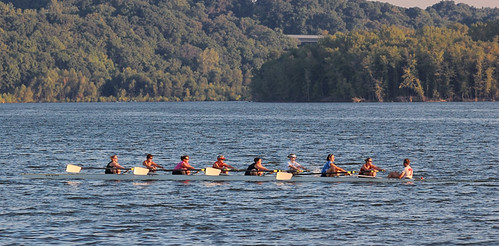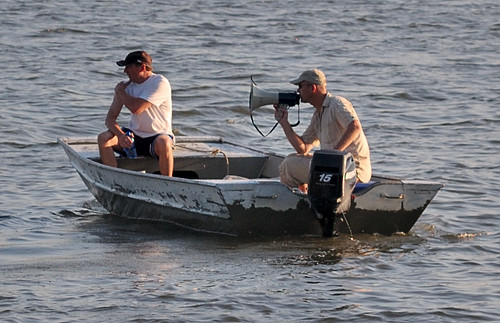Chartered in 1875, this was one of nine rowing clubs which owned boathouses on the banks of the Mississippi River. These groups held regattas at Creve Coeur Lake, which was also the venue for the rowing competitions of the 1904 Olympic Games. These clubs generally folded or became social clubs by the mid-1950s, and only became active again in the sport with the infusion of new enthusiasts in 1983. No longer rowing on the river, the club now has a large permanent boathouse in a cove on the lake.

Newbies getting a lesson in rowing.
Boats like these were developed specifically for sport use. Inspired by ancient Greece, secular Victorians believed that team sports helped promote health and cooperation, and was a benign outlet for the competitive spirit. Muddled sentiments perhaps, but these beliefs play a large part in contemporary life: by the late 19th century, formal team sports were organized worldwide.

Regular placement of the oars show that this is a more experienced group. According to Aristotle, the virtue of art — including the art of rowing — is seen in a person when his actions appear to be effortless and graceful.

Regular placement of the oars show that this is a more experienced group. According to Aristotle, the virtue of art — including the art of rowing — is seen in a person when his actions appear to be effortless and graceful.
In the United States, rowing is often called ‘crew’. This type of boat, called a shell or fine boat, is long, very narrow, and is inherently unstable, requiring the active use of oars and rower's balance to keep it upright. It can typically be used only in flat water.
Other distinctive features of these boats are sliding seats and fixed pivots for the oars, which makes the transfer of power from the muscles to the oars very efficient. The design of these boats mean that they are good for only a single purpose: going fast. Unlike a canoe, they are impractical for general water transportation.
This rower remarked that it was a bad day for boating: winds from the south (unusual for this region) generated waves that hit the boat broadside, which is a difficult and potentially dangerous situation.


I was standing on a bridge over the water, giving me good camera angles!





Mark I am puzzled by your use of the term secular Victorians. Would you take a moment and explain why this was contextual? While some sports have social/economic factors which lead to their practice by narrowed classes I believe that most do not reflect a secularist view today
ReplyDeleteI think 'secularist' is an accurate term.
ReplyDeleteSports and competition was very much a part of pagan Antiquity. Enlightenment thinkers, studying the past, thought that reintroducing formal games and organized sports would be a way of promoting virtue among the citizenry. The Olympic Games, in particular, were seen as a way of promoting peace amongst the nations; although sports were also thought of as a way to help train young men to prepare for war, especially as so much of the population had become sedentary following the Industrial Revolution.
The founders of the modern Olympic Movement were generally Freemasons, whom I think could fairly be called secularists. Although the Games were reestablished late in the 19th century, the movement got its start in Revolutionary France a century earlier.
But among numerous Protestant denominations of the time, games and amusements such as sports were abominable. Once I did a search of the writings of the Fathers of Church, and the Olympic Games were criticized thoroughly due to the "Cult of the Body": although certainly sports imagery was often used metaphorically by the spiritual writers.
From a purely class-conflict point of view, you may be interested that the distinction between amateurism and professionalism in sports has its roots in class: workers were enthusiastic about getting paid to do sport, while the college-educated upper and middle classes wanted purity in competition. Certainly the reorganization in society after industrialization meant that workers had very little time to practice sports unless they were getting paid to do it.
The typical Catholic viewpoint was more moderate: certainly Catholicism encouraged much leisure time, and moderate amusements were by no means prohibited. The idea of using sports as training for war would seem ridiculous: in the days before conscript armies and the nation-state, every man - and woman - would have to be practiced in the martial arts, and would naturally act when needed to defend the city walls. Also, the idea that reintroducing the competitive Olympic Games to promote peace seems somewhat strange, along with the evils that come from idolizing the body over the spirit.
Interesting...what about that concept of the body as temple of the holy spirit and that treating the body well and keeping it in good shape glorifies God??
ReplyDeleteSure. Being healthy, and taking care of your health is a good thing.
ReplyDeleteBut is football healthy?
So should every Catholic School: High School, College and University do away with contact sports like football, soccer, lacrosse, hockey.
ReplyDeleteAre they all guilty of promoting secularist activity? I even thought lets see if Ava Marie in Florida has some of these sports and geez they do the Gyrenes play soccer and even that most violent of sports rugby?
correction and point: I miss spelled Ava Maria and let me suggest that you go to that universities athletic page and read Pope John Paul's II statement on sport
ReplyDelete